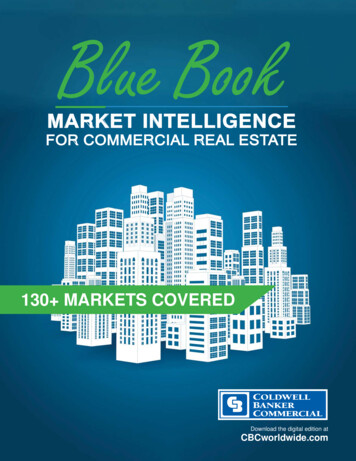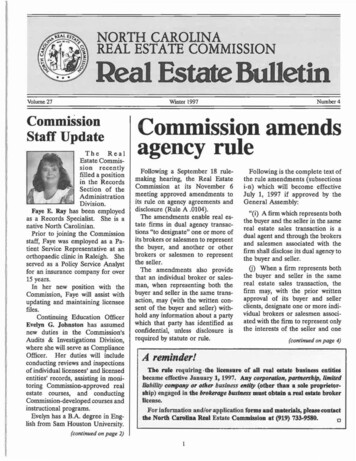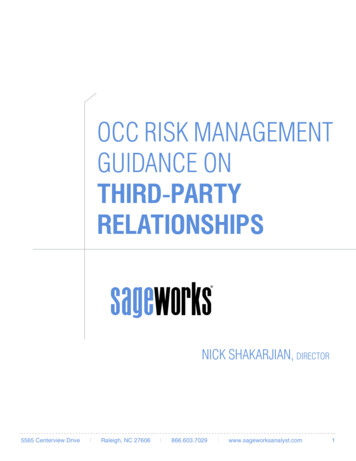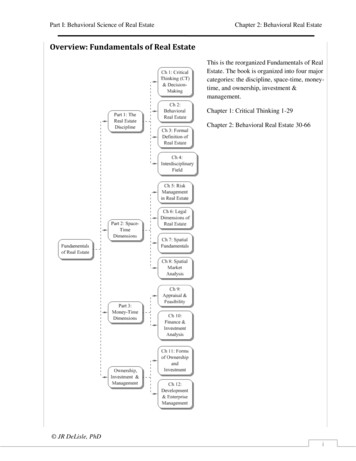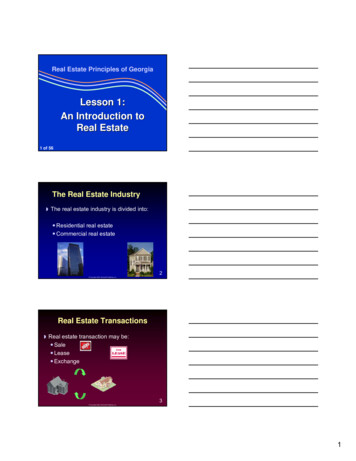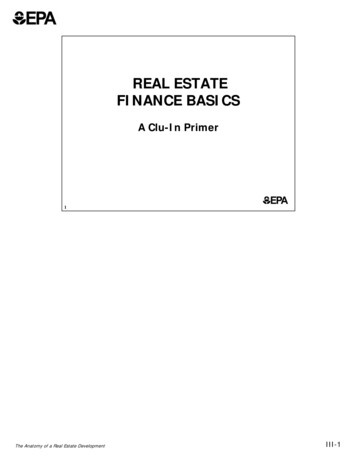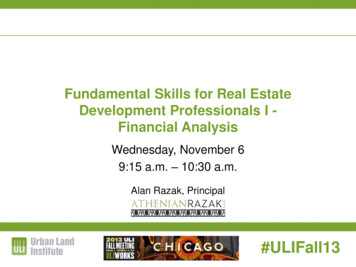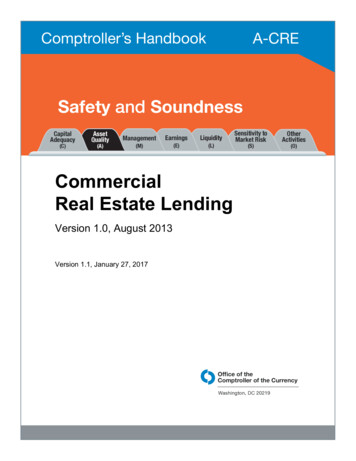
Transcription
Comptroller’s HandbookA-CRESafety and nt(M)Earnings(E)Liquidity(L)Sensitivity toMarket Risk(S)OtherActivities(O)CommercialReal Estate LendingVersion 1.0, August 2013Version 1.1, January 27, 2017Office of theComptroller of the CurrencyWashington, DC 20219
Version 1.1ContentsIntroduction .1Overview . 1Background . 1Authority and Limits . 1Real Estate Markets . 2Risks Associated With CRE Lending . 3Credit Risk . 3Interest Rate Risk . 4Liquidity Risk . 5Operational Risk . 5Compliance Risk . 6Strategic Risk . 6Reputation Risk. 6Risk Management . 7Real Estate Lending Standards . 7Acquisition, Development, and Construction Lending. 16Income-Producing Real Estate Lending . 36Analysis of Borrower’s and Guarantor’s Financial Condition . 55Loans Secured by Owner-Occupied Properties . 56File Documentation. 57Appraisals and Evaluations . 59CRE Concentrations of Credit . 63Environmental Risk Management. 69Risk Rating CRE Loans . 72Analyzing Repayment Capacity of the Borrower . 72Evaluating Guarantees . 72Assessing Collateral Values . 73Other Considerations . 74Classification of CRE Loans . 75Loan Review . 77Loan Workouts and Restructures . 78Allowance for Loan and Lease Losses . 81Foreclosure . 81Examination Procedures .82Scope . 82Quantity of Risk . 85Quality of Risk Management . 90Conclusions . 96Internal Control Questionnaire . 98Verification Procedures . 115
Version 1.1ContentsAppendixes.117Appendix A: Quantity of Credit Risk Indicators . 117Appendix B: Quality of Credit Risk Management Indicators . 119Appendix C: Glossary . 122References .127Table of Updates Since Publication .130Comptroller’s HandbookiiCommercial Real Estate Lending
Version 1.1Introduction OverviewIntroductionThe Office of the Comptroller of the Currency’s (OCC) Comptroller’s Handbook booklet,“Commercial Real Estate Lending,” provides guidance for bank examiners and bankers oncommercial real estate (CRE) lending activities. For the purposes of this booklet, CRElending comprises acquisition, development, and construction (ADC) financing and thefinancing of income-producing real estate. Income-producing real estate comprises real estateheld for lease to third parties and nonresidential real estate that is occupied by its owner or arelated party.The booklet addresses the risks inherent in CRE lending as well as risks unique to specificlending activities and property types. Also discussed are supervisory expectations andregulatory requirements for prudent risk management.The booklet includes expanded examination procedures to assist examiners in completingbank core assessments that are affected by CRE lending. The procedures include an internalcontrol questionnaire and verification procedures to further support the examination process.Throughout this booklet, national banks and federal savings associations are referred tocollectively as banks, except when it is necessary to distinguish between the two.OverviewBackgroundCRE lending is an important line of business for the banking industry, and CRE activitiescontribute significantly to the U.S. economy. Many banks rely on revenue from this businessto grow and prosper. History has shown, however, that imprudent risk taking and inadequaterisk management, particularly during periods of rapid economic growth, can lead tosignificant losses and be a major cause of bank failures.One of the key elements of risk in this type of lending is the cyclical nature of real estatemarkets where, as markets peak and decline, banks with large concentrations of CRE loansmay suffer considerable distress. While the banking industry cannot accurately predict orcontrol the timing of the real estate business cycle, banks that demonstrate faithful adherenceto prudent lending practices and regulatory guidance can keep losses from CRE lending to amanageable level, even when markets experience significant stress.Authority and LimitsBanks are permitted by statute to engage in real estate lending. The authority for nationalbanks is found in 12 USC 371, while the authority for federal savings associations is found in12 USC 1464. Both national banks and federal savings associations are subject to a uniformrule on real estate lending, which incorporates the “Interagency Guidelines for Real EstateComptroller’s Handbook1Commercial Real Estate Lending
Version 1.1Introduction OverviewLending Policies.” This rule can be found in 12 CFR 34, subpart D for national banks and in12 CFR 160.101 for federal savings associations.No aggregate exposure limit applies to a national bank’s real estate lending activities, as longas the volume and nature of the lending does not pose unwarranted risk to the bank’sfinancial condition. Permissible real estate exposures for federal savings associations aredescribed in 12 USC 1464 of the Home Owner’s Loan Act (HOLA). 12 USC 1464(c)(1)(B)authorizes federal savings associations to invest in residential real estate loans, includingmultifamily residential real estate loans, without limit provided the volume and nature of thelending does not pose unwarranted risk to the federal savings association’s financialcondition. Nonresidential real estate lending is limited under 12 USC 1464(c)(2)(B) to 400percent of total capital 1 (note, however, that concentration concerns may arise with aggregateexposure of substantially less than 400 percent of capital). 2 A federal savings association thatmakes a loan secured by nonresidential real estate also has the option to classify that loan asa commercial loan as authorized under 12 USC 1464(c)(2)(A). 3Real Estate MarketsReal estate is a highly cyclical industry that is affected by changes in local and nationaleconomic conditions. Although national conditions affect the overall real estate industry,how national conditions influence local conditions is most important. Factors such as rates ofemployment, consumer demand, household formation, and the level of economic activity canvary widely from state to state and among metropolitan areas, cities, and towns. Metropolitanmarkets comprise various submarkets where property values and demand can be affected bymany factors, such as demographic makeup, geographic features, transportation, recreation,local government, school systems, utility infrastructure, tax burden, building-stock age,zoning and building codes, and available land for development.In addition to geographic considerations, markets can be defined by property type. A bank’sCRE lending strategy may target one or more of the five primary real estate sectors:1Without regard to any limitations of this part, a federal savings association may make or invest in the fullyinsured or guaranteed portion of nonresidential real estate loans insured or guaranteed by the EconomicDevelopment Administration, the Farmers Home Administration or its successor the Farm Service Agency, orthe Small Business Administration. Unguaranteed portions of guaranteed loans must be aggregated withuninsured loans when determining an association's compliance with the 400 percent of capital limitation forother real estate loans.2The OCC may approve an exception to the nonresidential real estate lending limit pursuant to1464(c)(2)(B)(ii) upon the OCC’s determination that the exception poses no significant risk to safe and soundoperation and is consistent with prudent operating practice. If an exception is granted, the OCC will closelymonitor the federal savings association’s condition and lending activities to ensure that nonresidential real estateloans are made in a safe and sound manner in compliance with all relevant laws and regulations.3Under 12 CFR 1464(c)(2)(A), federal savings associations may invest up to 20 percent of their assets incommercial loans, provided that amounts in excess of 10 percent of total assets may be used only for smallbusiness loans.Comptroller’s Handbook2Commercial Real Estate Lending
Version 1.1Introduction Risks Associated With Real Estate Lendingoffice, retail, industrial, hospitality, and residential, which includes multifamily and one- tofour-family development and construction. While all sectors are influenced by economicconditions, some sectors are more sensitive to certain economic factors than others.The demand for office space depends on office-related employment, which tends to beconcentrated in the finance, insurance, technology, and real estate industries, as well as somecategories of services, particularly business services. The demand for retail space is affectedby local employment levels and consumer spending. Demand for industrial space tends to beinfluenced by proximity to labor, transportation infrastructure, local tax rates, and thepresence of a similar or related industry. The hospitality sector is affected locally by the levelof business activity but is also influenced by consumer spending, the cost of travel and thestrength of the U.S. dollar. In the residential sector, demand is heavily influenced by the localquality of life, demographics, affordability of homeownership, the rate of householdformations, and local employment conditions.Banks are expected to monitor the conditions in the markets where they are active andconsider them in their monitoring and lending strategies.Risks Associated With CRE LendingFrom a supervisory perspective, risk is the potential that events, expected or unexpected, willhave an adverse effect on a bank’s earnings, capital, or franchise or enterprise value. TheOCC has defined eight categories of risk for bank supervision purposes: credit, interest rate,liquidity, price, operational, compliance, strategic, and reputation. These categories are notmutually exclusive. Any product or service may expose a bank to multiple risks. Risks alsomay be interdependent and may be positively or negatively correlated. Examiners should beaware of this interdependence and assess the effect in a consistent and inclusive manner.Refer to the “Bank Supervision Process” booklet of the Comptroller’s Handbook for anexpanded discussion of banking risks and their definitions.The risks associated with CRE lending in particular are credit, interest rate, liquidity,operational, compliance, strategic, and reputation. The OCC expects banks to appropriatelyidentify, measure, monitor, and control risk by implementing an effective risk managementsystem. When examiners assess the effectiveness of a bank’s risk management system, theyconsider its policies, processes, personnel, and control systems.Credit RiskFactors that can affect a bank’s likelihood of receiving repayment as expected for loansfinancing CRE include the following.Construction issues: Banks that finance construction assume the risk associated with aborrower’s ability to successfully complete a proposed project on time and within budget.Budget overruns can result in total costs that exceed the property’s value when completed.Overruns may be caused by inaccurate budgets, increases in materials or transportationexpenses, material or labor shortages, substandard work performed by the borrower’semployees or subcontractors that must be redone to satisfy contract performance conditionsComptroller’s Handbook3Commercial Real Estate Lending
Version 1.1Introduction Risks Associated With Real Estate Lendingor to meet local building codes, increased interest expense, or delays caused by inclementweather. Projects that rehabilitate or extensively modify existing buildings can beexceptionally vulnerable to overruns because costs in these cases are more difficult toproject.Market conditions: A property’s performance can be negatively affected by tenants’deteriorating credit strength and lease expirations in times of softening demand caused byeconomic deterioration or over-supply conditions. As the economic climate deteriorates,tenants may reduce their space or cease operations and the payment of rent altogether.Properties that have shorter lease terms are vulnerable to declining market values as rentsdecline and leases are renewed at lower rental rates. Leases with longer lease terms may alsobecome vulnerable in softening markets as tenants seek to negotiate the renewal of theirleases early to take advantage of the lower rates. As expiring leases cause project cash flowsto decline, developers may be unable to meet scheduled mortgage payments and otherimportant obligations, such as property taxes and maintenance. Even if borrowers are able tomeet their payment obligations, they may find it difficult to refinance their full loan amountsat maturity due to declines in property value.The risk from changing market conditions can be considerable in ADC financing of for-saledevelopments. Adverse changes in the market occurring between the start of developmentand completion can result in slower sales rates and lower sales prices that could threatentimely and full repayment. Risk posed by changing market conditions is magnified to theextent that portfolio concentrations of CRE are present.Regulatory changes: At the national or local level, changes in tax legislation, zoning,environmental regulation, or similar external conditions may affect property values and theeconomic feasibility of existing and proposed real estate projects.Interest rates: Interest rates affect the cost of construction and the financial viability of areal estate project. When a project has floating rate debt and fixed rents, increasing interestrates may have a negative effect on repayment capacity. Higher interest rates may also resultin higher capitalization rates, thereby reducing a property’s value. While borrowers canhedge their interest rate risk sensitivity by using interest rate derivatives, mitigation isdifficult for construction facilities due to the changes in the outstanding loan amount duringdevelopment.Environmental liability: Contamination may decrease the collateral’s value or render thecollateral worthless. Furthermore, the cost that may be imposed on a responsible borrowerfor the remediation of a contaminated property may severely impair the borrower’s ability torepay the loan.Interest Rate RiskThe level of interest rate risk attributed to the bank’s CRE lending activities depends on thecomposition of its loan portfolio and the degree to which the structure of its loans, such astenor, pricing, and amortization, expose the bank’s revenue to changes in interest rates.Comptroller’s Handbook4Commercial Real Estate Lending
Version 1.1Introduction Risks Associated With Real Estate LendingMuch of the CRE financing provided by banks is on a floating-rate basis, meaning theinterest rate sensitivity for the lending bank, is relatively low. Banks that provide fixed-ratefinancing for extended terms, however, expose themselves to interest rate risk to the extentthat these loans are funded by shorter-term liabilities.Liquidity RiskCRE loans are ordinarily illiquid. The conversion of CRE loans to cash can be accomplishedby (1) refinancing the loan with another lender; (2) through the sale of the loan to an investor(either on a participation, whole-loan, or portfolio basis); 4 (3) by securitizing the loan;(4) through normal repayment by the borrower; or (5) by serving as collateral forborrowings. 5Sales of CRE loans are difficult to execute largely because of their lack of homogeneity.Unlike consumer loans, the due diligence process can be time-consuming and expensive for aprospective purchaser because of variations in property type, location desirability, tenantquality and other rent roll characteristics, underwriting, loan structures and, documentation.CRE loans tend to be even less liquid in times of market stress, when potential fundingsources diminish as lenders allocate fewer funds for real estate. This can make the sale ofloans or their refinance by other lenders as a strategy to manage concentrations ineffective.ADC loans are particularly illiquid because of their short tenor and because
Commercial Real Estate Lending Version 1.0, August 2013 Version 1.1, January 27, 2017. . Nonresidential real estate lending is limited under 12 USC 1464(c)(2)(B) to 400 . have an adverse effect on a bank’s earnings, capital, or franchise or enterprise value. TheFile Size: 772KB

